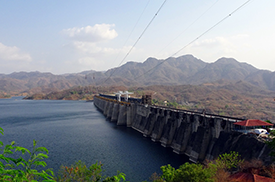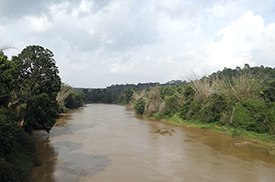GWAVA model case studies and previous projects
Case studies
Originally developed by the Institute of Hydrology (now the Centre for Ecology & Hydrology), GWAVA has been used extensively in water resource assessments across the world (Meigh et al, 1999). Some examples of projects where GWAVA is currently being applied include:
NanoFATE
- NanoFATE was an EU Framework 7 project consortium investigating the fate and effect of engineered nanoparticles in the environment: from their entry into the environment, through their final destination in organisms or the environment where their potential toxic effects were studied.
- GWAVA was used to provide nano silver and nano zinc-oxide exposure estimates for Europe under current and future scenarios. This successful project is continued in the current NanoFASE project, which also uses GWAVA.
AMMA 2050
- The African Monsoon Multidisciplinary Analysis (AMMA) 2050 project looks at the impact of climate change on the monsoon cycle and high impact weather in West Africa. The effect such changes may have on the people living in the region and various economic sectors is also considered.
- GWAVA is being used to interpret and quantify the effects of projected changes to the monsoon regime on future water availability. This will be done in light of the CMIP5 climate projections. The results of this modelling work will support climate-compatible development work in West Africa.
Narmada Basin
-
Image

The 'Water climate services to inform food and water security in India' project uses local data to assess the significance of future change on water availability and environmental flows in the Narmada Basin, India. This project is in collaboration with the National Institute of Hydrology, India and University College London.
- The open and flexible model structure of GWAVA allows the extensive system of reservoirs and irrigation command areas in the basin to be represented, along with how physical and socio-economic changes may alter the management of these systems up to the year 2060.
UPSCAPE
-
Image

UPSCAPE looks at future water availability in south India, modelling the water resources of the Cauvery Basin, which is already under pressure. The UPSCAPE GWAVA model will allow the impacts of current and future interventions to be addressed in basin-scale water decision-making.
- This collaboration between UK and Indian researchers will use the GWAVA's code adaptability to incorporate research conducted on urban and rural test catchments.
- Realistic future scenarios of change derived from social science will be implemented in GWAVA and used to stress-test the modelled basin.
Previous Projects
Project: EU PROMISE
Location: West Africa
Year: 2000-2003
Project Aims
To better understand the impacts of anthropogenic climate in tropical countries, particularly upon the availability of water resources, crop productivity and potential changes in natural vegetation.
Role of GWAVA
To represent spatial and temporal variation in water availability and demands, so as to avoid the distortions that occur in national averages. GWAVA was also used to examine potential changes in water stress for a range of scenarios, including climate, population, water demands and land use changes.
Key Publications
Meigh J R, Folwell, S, Sullivan, C A, 2005. "Linking water resources and global change in West Africa: options for assessment". In: Wagener, T, Franks, S, Gupta, H V, Bogh, E, Bastidas, L, Nobre, C, de Oliveira Galvao, C (eds)
Regional hydrological impacts of climate change: impact assessment and decision-making: Proceedings symposium 6 at IAHS 2005, Foz do Iguassu, Brazil, 3-8 April, IAHS, Issue 295, p 297-306.
Key Links: PROMISE Final Report
Project: EU TWINLATIN
Location: South America
Year: 2005-2009
Project Aims
To assess the impact of climate change on hydrological regimes, water availability and quality in river basins in Latin America. To create a fully integrated model of water resources, including water quality and availability, and hydropower stakeholders interests.
Role of GWAVA
To provide a broader regional picture of hydrology and spatial extents of water scarcity, both for the present situation and for projected future scenarios.
Key Links: TWINLATIN Final Report
Project: EU SCENES
Location: Europe
Year: 2006-2011
Project Aims
To use qualitative and quantitative methods to investigate the future of Europe's water resources. The project acknowledges Europe's hydrological, ecological, economic, cultural, social, climatic and financial water futures.
Key Publications
Kämäri, J, Alcamo, J, Bärlund, I, Duel, H, Farquharson, F, Flörke, M, Fry, M, Houghton-Carr, H, Kabat, P, Kaljonen, M, Kok, K, Meiher, K S, Rekolainen, S, Sendzimir, J, Varjopuro, R, Villars, N, 2008. Envisioning the future of water in Europe - the SCENES project. E-Water - Official Publication of the European Water Association (EWA).
Project: EU WATCH
Location: Global
Year: 2007-2011
Project Aims
To analyse, quantify and predict components of current and future global water cycles and related water resources.
Role of GWAVA
To clarify the overall vulnerability of global water resources related to the main societal and economic sectors.
Key Publications
Taylor, C M, de Jeu R A M, Guichard, F, Harris, P P, Dorigo, W A, 2012. Afternoon rain more likely over drier soils, Nature, 489: 423-426
Project: EU PHARMAS
Location: Europe
Year: 2011-2013
Project Aims
To assess the concentrations and risks of pharmaceuticals in riverine environments and drinking water to both humans and animals.
Role of GWAVA
To predict antibiotic concentrations in rivers across Europe.
Key Publications
Johnson, A C, Keller, V D J, Dumont, E, Sumpter, J P, 2015. Assessing the concentrations and risks of toxicity from the antibiotics ciprofloxacin, sulfamethoxazole, trimethoprim and erythromycin in European rivers. Science of the Total Environment, 511, 747-755.
Project: UK Droughts and Water Scarcity
Location: UK
Year: 2013-2018
To identify new solutions to droughts and water scarcity, which enables users to identify, predict and respond to drought events, and to better understand the interrelationships between their multiple drivers and impacts.
Key Publications
Williams, R, Neal, C, Jarvie, H, Johnson, A, Whitehead, P, Bowes, M, Jenkins, A, 2015. Water Quality, in Progress in Modern Hydrology: Past, Present and Future, First Edition, Rodda, J C, Robinson, M (eds), Wiley and Sons Ltd.
Project: Yellow River
Location: China
Year: 2015
Project Aims
To investigate the impact of increased concentrations of human-sourced oestrogens in the Yellow River upon ecology, particularly the feminisation of fish species.
Role of GWAVA
To model human-sourced steroid oestrogens (estrone and estradiol) through incorporating regional water abstractions and reservoir information.
Key Publications
Lui, X, Keller, V D J, Dumont, E L, Shi, J, Johnson, A C, 2015. Risk of endocrine disruption to fish in the Yellow River catchment in China assessed using a spatially explicit model. Environmental Toxicology and Chemistry, 34 (12), 2870-2877.
The GWAVA Team
Virginie Keller
Nathan Rickards
For further information, please contact:
Centre for Ecology & Hydrology
Wallingford
OX10 8BB
Email: vke@ceh.ac.uk
References
Dumont, E, Williams, R, Keller, V, Voß, A, Tattari, S. 2012. Modelling indicators of water security, water pollution and aquatic biodiversity in Europe. Hydrological Sciences Journal, 57(7): 1378-1403.
Johnson, A C, Keller, V D J, Dumont, E, Sumpter, J P, 2015. Assessing the concentrations and risks of toxicity from the antibiotics ciprofloxacin, sulfamethoxazole, trimethoprim and erythromycin in European rivers. Science of the Total Environment, 511: 747-755.
Laizé, C L R, Acreman, M C, Schneider, C, Dunbar, M J, Houghton-Carr, H A, Flörke, M and Hannah, D M, 2013 Projected flow alteration and ecological risk for pan-European rivers. River Research and Applications, 30: 299-314.
Meigh, J, McKenzie, A, and Sene, K, 1999. A grid-based approach to water scarcity estimates for eastern and southern Africa. Water Resources Management, 13: 85-115.
Moore, 1985. The probability-distributed principle and runoff production at point and basin scales. Hydrological Sciences Journal, 30: 273-297.